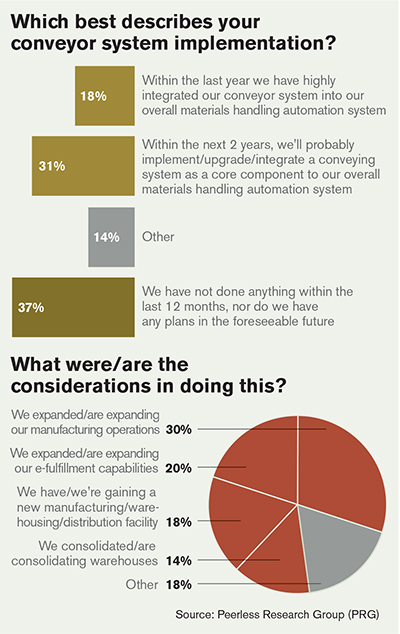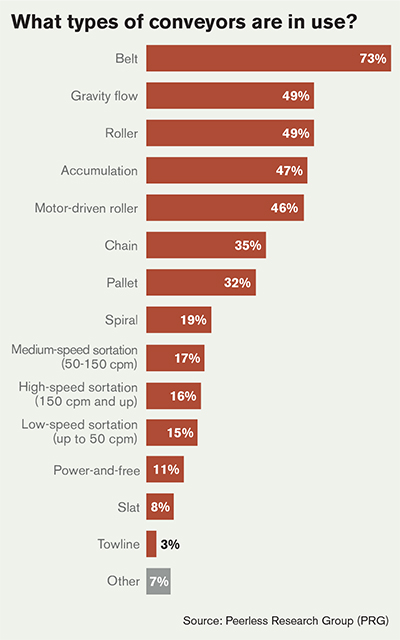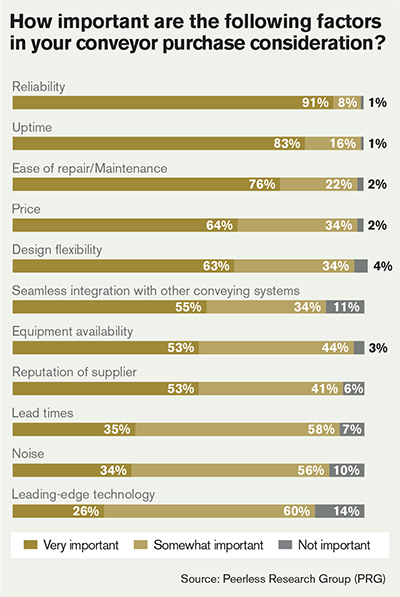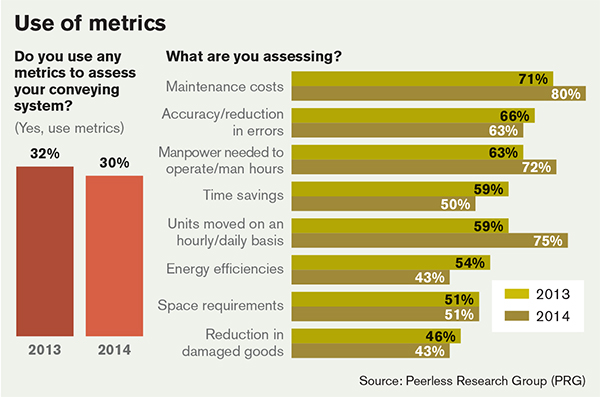Reader Survey: Conveyor technology’s silver lining
Manufacturers and distributors have been on an automation binge. We asked Modern’s readers what those plans may mean for the conveyor and sortation industry.
Latest Material Handling News
Registration open for Pack Expo International 2024 Walmart chooses Swisslog AS/RS and software for third milk processing facility NetLogistik partners with Vuzix subsidiary Moviynt to offer mobility solutions for warehouses Lucas Watson appointed CSO for Körber’s Parcel Logistics business in North America Hyster recognizes Dealers of Distinction for 2023 More NewsLast year, nearly 40% of the respondents to Modern’s annual conveyor and sortation survey told us they plan to increase the amount of conveyor equipment over the next two years; only 5% were planning reductions. Twenty-six percent (26%) of these readers said they would increase their use of sortation equipment.
This year, the results were an almost mirror image of 2013. Once again, 40% of respondents say they plan to increase their level of conveyor usage while 25% plan to increase the level of sortation usage during the next two years. While some may see that consistency as evidence of a flat market, we see a silver lining. To us, it indicates stability in one of the components of an automated materials handling industry that grew by 7% in 2013 and is projected by the industry group MHI to grow by 12% in 2015. After all, wouldn’t most of us get an “attaboy” at work if we could tell our bosses that 40% of our customers plan to increase their use of our products in the coming years?
For further evidence of stability, consider that the average planned expenditure on conveyor systems, parts and accessories in the next 12 months is $233,875 compared to $236,480 in 2013.
Both years showed a marked increase from the $164,000 readers planned to spend on average on conveyor equipment in 2012. And, 21% plan to spend more than the average, including 12% who plan to spend more than $1 million on conveyor systems in the next 12 months.
Reader plans for conveyor spending was only one of the questions we asked in our annual survey. We also looked at how Modern readers plan to deploy conveyor technologies in the future and whether they plan to re-evaluate their distribution processes—changes that could affect how conveyor technology is put to use. To answer those questions, we surveyed e-mail subscribers of Modern as well as a sample of recipients of our e-newsletters.

As in years past, respondents represented a number of different industries, a range of company revenue sizes and a healthy mix of manufacturing (42%), distribution centers (24%) and warehouses (22%). Here’s what we learned.
From belt to towline
From belt to towline conveyors, the conveyor industry offers a diverse mix of products. Modern’s readers are employing them all, including
- 73% are using belt conveyor,
- 49% are using roller conveyor,
- 49% are using gravity flow conveyor,
- 47% are using accumulation conveyor, and
- 46% are using motor-driven roller conveyor.
Those systems are used to convey a variety of products, indicating the importance of flexibility. For instance, 58% of respondents are handling cases and boxes; 43% are handling pallets including mixed SKU pallets (14%); 37% are handling items; 29% are handling plastic totes and pallets; 16% are handling poly-bagged items; and 10% are handling beverage cartons.
The systems are also configured to handle a variety of sizes with 56% of respondents handling pallets of varying sizes and 85% of respondents handling unit loads, cartons, totes or items of varying sizes.

Reliability counts
As in years past, the survey looked at the factors that are important in the purchase of a conveyor system and the factors users say they are willing to pay more for in conveyor equipment.
Reliability remains at the top of the list as very important (91%) or somewhat important (8%) to almost every respondent. With that in mind, it’s no surprise that 99% of respondents also say that uptime is very (83%) or somewhat (16%) important; or that 98% indicate that ease of repair and maintenance is very (76%) or somewhat (22%) important.
While we were hardly surprised that 98% of respondents look at the price tag, we also found that design flexibility (97%) and seamless integration with other conveying systems (89%) are also considered very or somewhat important to respondents.
Of less importance are the reputation of the supplier, ranked as very important by just 53% of respondents, and leading edge technology, which is very important to just 26% of respondents.

Most respondents say they are willing to pay more for features they deemed most important: 60% say they are willing to pay more for reliability; 58% say they are willing to pay more for ease of repair and maintenance; 53% say they are willing to pay more for design flexibility; and 40% are willing to pay more for seamless integration with other conveying systems.
The emphasis on reliability, flexibility and ease of maintenance likely reflects the real-time nature of today’s operations, especially facilities filling e-commerce and direct-to-consumer orders with tight order cutoff times. If a conveyor system goes down, there is no time to recover and get orders out the door.
In a related question, 30% of respondents say they are using metrics to assess their conveyor systems:
- 80% are measuring maintenance costs,
- 75% are measuring the units moved on an hourly/daily basis,
- 72% are measuring the man hours needed to operate the system,
- 63% are measuring the accuracy or reduction in errors,
- 51% are measuring the space requirements for the system, and
- 50% are measuring the time savings realized from the system.
Are distribution processes changing?
Conveyor and sortation systems are no longer used as simple transportation of product from point A to point B, such as from the receiving dock to storage, or a pick zone to the shipping dock. Today, they are integral component of an overall order fulfillment solution. While that may not be the case in all facilities, it is certainly true of retailers and industrial distributors ramping up e-commerce activities and manufacturers filling drop shipment orders or shipping smaller and more frequent orders.
This year, 40% of respondents say they are extremely likely (8%), very likely (13%) or somewhat likely (19%) to evaluate changing their order fulfillment processes within the next two years. While that is fewer than half of respondents, its important to remember that there is a continuum in all industries, from competitors at the early stages of their journey toward automation to sophisticated competitors who have recently completed projects that are now going live. The fact that 40% of respondents plan to re-evaluate their processes indicates a significant amount of activity.

The answers to other questions support that conclusion. For example, nearly a third of respondents say they have implemented or are considering the implementation of a goods-to-person order fulfillment solution, an approach that uses automation, including conveyors, to eliminate walking by delivering totes, cartons or pallets to a picking station.
Moreover, 44% of respondents agree that the way in which businesses are handling distribution processes is changing.
- “Most businesses need to adjust to the competition,” wrote one respondent. “Those that do not will lose competitiveness.”
- “The shift toward omni-channel fulfillment creates more needs for flexible processes,” wrote another.
- “There are fewer people and more automation and robotics in warehouses today,” wrote a third.
In fact, 49% of respondents say they made some change to their conveyor system. And, 18% say they highly integrated their conveyor systems into their overall materials handling automation system in the last year and 31% say they expected to implement/upgrade/integrate a conveyor system as a core component to an overall materials handling system in the near future.
There are a number of catalysts for these projects, including:
- 30% are expanding manufacturing operations,
- 20% are expanding e-fulfillment capabilities,
- 18% are adding a new manufacturing or distribution facility, and
- 14% are consolidating facilities.
“Our order fulfillment methods need to be assessed to ensure they are appropriate for each of the channels we serve,” one respondent explained.
“We are looking at making our manufacturing more lean, with touching the parts fewer times and moving them in smarter ways,” said another.
While conveyor systems in the future may require less conveyor—as manufacturers and distributors alike get lean, touch parts fewer times and move product in smarter ways—they will continue to be an integral part of solutions that drive efficient distribution.

Survey profile
The conveyor usage study was conducted by Peerless Research Group (PRG) on behalf of Modern Materials Handling. The survey was e-mailed to subscribers to Modern Materials Handling who are personally involved in the evaluation and purchase of conveyor equipment for their companies. The results were based on the responses of 247 qualified materials handling professionals.
The average company revenue was $832 million; however, 17% of respondents reported revenues greater than $1 billion and 12% reported revenues between $250 and $999.9 million.

The average facility size was 285,230 square feet, with 19% of respondents working in facilities with 500,000 square feet or more, and 13% working in facilities with between 250,000 and 499,999 square feet.
Copies of the complete research can be found here.

Article Topics
Latest in Materials Handling
Registration open for Pack Expo International 2024 Walmart chooses Swisslog AS/RS and software for third milk processing facility NetLogistik partners with Vuzix subsidiary Moviynt to offer mobility solutions for warehouses Materials Handling Robotics: The new world of heterogeneous robotic integration BSLBATT is looking for new distributors and resellers worldwide Lucas Watson appointed CSO for Körber’s Parcel Logistics business in North America Hyster recognizes Dealers of Distinction for 2023 More Materials HandlingAbout the Author
Subscribe to Materials Handling Magazine

Find out what the world's most innovative companies are doing to improve productivity in their plants and distribution centers.
Start your FREE subscription today.
April 2024 Modern Materials Handling

Latest Resources










